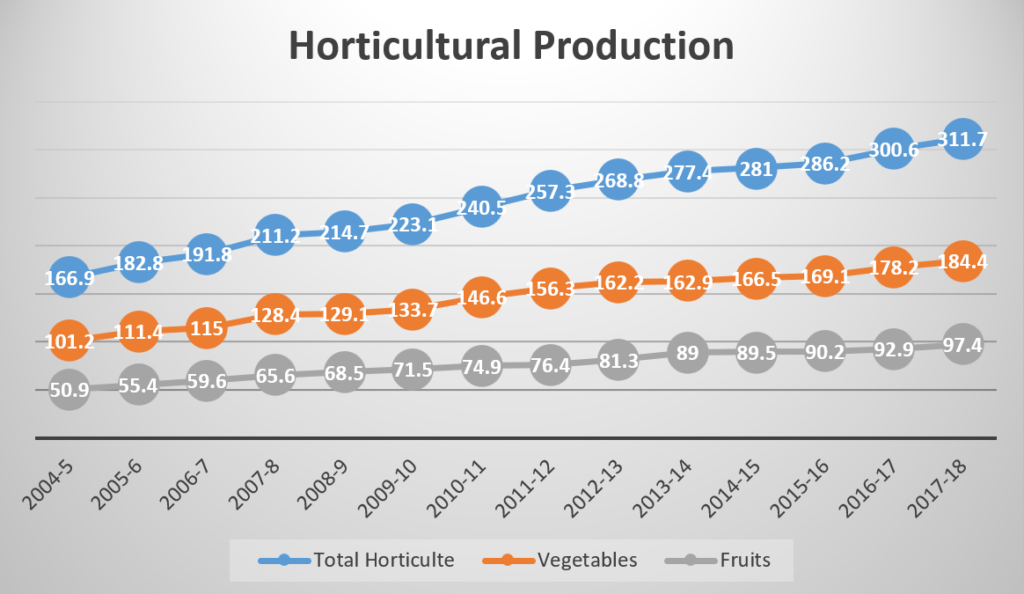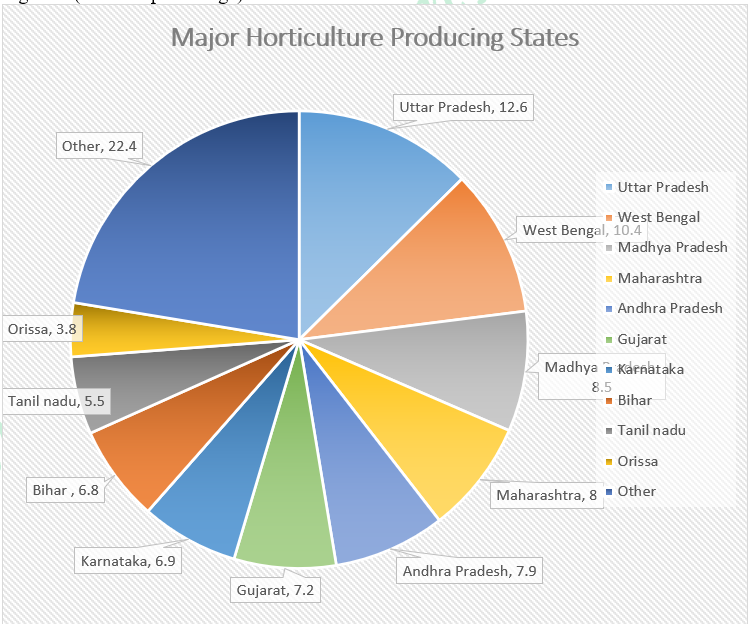Horticulture Guruji
Horticulture- Definition, Branches, Importance and Scope
The word ‘Horticulture’ came into existence in the seventeenth century. It is found mentioned in Peter Lauremberg’s treatise written in 1631. E. Phillips used the word ‘Horticulture’ in his book ‘The New World of English Words’ (1678).
Horticulture:-
In Horticulture the words ‘Hortus’ and ‘Colere’ are the Latin words, which are means ‘garden’ and ‘to cultivate’ respectively, therefore Horticulture a branch of Agriculture in which garden crops are studied, garden crops such as fruits, vegetables, plantation, flowers, spices, medicinal and aromatic crops.
Watch Lecture Video
Branches of Horticulture
- Pomology: – The word Pomology is made up of the Latin language word ‘Pomum’ meaning ‘fruits’ and Greek language word ‘logy’ meaning ‘science’ and thus the science of fruit production is called Pomology.
- Olericulture: – The word Olericulture is composed of the Latin language word ‘Oleris’ meaning ‘pot Herb’ and the English word ‘culture’ meaning ‘to cultivate’, so the science of growing vegetables is called Olericulture.
- Floriculture: – The science of cultivation of flowers and ornamental plants is called floriculture.
- Landscape gardening: – The art of making a part beautiful with ornamental plants and gardening methods is called landscape gardening.
In addition, agriculture additionally covers spices, plantation, medicinal and aromatic crops and postharvest handling of all these crops go under its see.
Importance and Scope
The scenario of horticulture crops in India has become very encouraging. The percentage share of horticulture output in Agriculture has become 33%. Under the purview of Agriculture & allied activities, the share of plan outlay for Horticulture which was 3.9% during the IX Plan, has increased to 4.6% during the XII Plan.
According to NHB (2021-22), India has witnessed an increase in horticulture production over the last few years. Significant progress has been made in area expansion resulting in higher production. During 2021-22, the production of horticulture crops was 342.33 Million Tonnes from an area of 28.75 million Hectares. The production of vegetables has increased from 101.2 Million Tonnes to 204.84 Million Tonnes from 2004-05 to 2021-22 and the production of fruits has increased from 50.9 Million Tonnes to 107.24 Million Tonnes since 2004-05 from 2021-22. The area under fruit cultivation was 7.49 million hectares while that of vegetables was 11.35 million hectares (NHB 2021-22)
According to FAO (2021), India is the largest producer of ginger and okra among vegetables and second in the production of potato, onion, cauliflower, brinjal, cabbage, etc. In fruits, the country ranks first in the production of Bananas (26.45%), Mango (including Mangosteen and Guava) (43.80%), and Papaya (39.30%).
This huge production base provides tremendous opportunities for exports to India. During 2022-23, India exports fresh fruits and vegetables worth INR 13185.30 Crore / US$ 1635.95 Million. Which included fresh fruits worth Rs. 6,219.46 Crore/ 770.70 USD Million and Vegetables worth Rs. 6,965.83 Crore/ US$ 865.24 Million.
Grapes, pomegranates, mangoes, bananas, and oranges form the bulk of the fruits exported from the country, while onions, mixed vegetables, potatoes, tomatoes, and green chilies contribute largely to the vegetable export basket.
Figure 1 (Production in MT)

Figure 2 (Share in percentage)

Figure 3 Production Share of various Horticulture crops (in %)

Table:- Area, Production and Productivity of Horticultural Crops
|
Crops |
Area (000, ha) |
Production (000, MT) |
Productivity (MT/ha) |
|
Fruits |
7049 |
107242 |
15.21 |
|
Vegetables |
11348 |
204835 |
18.05 |
|
Flowers, and Aromatic Crops |
951 |
3128 |
3.28 |
|
Plantation Crops |
4239 |
15488 |
3.65 |
|
Spices |
4487 |
10814 |
2.41 |
|
Total |
28074 |
341507 |
12.16 |
India is the second-largest country in fruits and vegetable production in the world and China ranks first in production. India ranks first in mango, banana, coconut, cashew nuts, papaya and pomegranate production and the productivity of some fruits is also very high like papaya, banana etc.
It is estimated that per capita fruits availability in our country is 207.9 gms. per day which is far below the recommended quantity of 230 gms. per capita per day
In view of these, there is a lot of scope of increasing production and potentiality of horticultural crops.
Apart from fruits and vegetables, floriculture industry in India comprising of trade of nursery plants, potted plants, seed and bulb products etc. is being observed as a sunrise industry.
Plantation crops are another potential sector with a lot of opportunities of employment generation, foreign exchange earning and overall supporting livelihood sustenance of mankind at large.
The importance of horticulture is as follows
1. Income generation: – More money can be earned by selling fruits, vegetables and plantation crops as they have a higher yield per hectare, and the demand for spices and medicinal plants is high as they produce a lot of medicines.
2. Employment Generation: – Horticulture crops require workers throughout the year, from growing crops to harvesting and in processing, so garden crops create more jobs.
3. Industrial development: –Horticultural crops like potatoes, tomatoes, mangoes and planting crops give raw materials to factories. These factories make products from them and sell them in the market.
4. Religious and sacred value: – Tree leaves, flowers, fruits, etc., are of religious importance which is used in rituals, sanskars and ceremonies. As coconut and turmeric are used in puja, the leaves of the Beal are offered to Lord Shiva and Tulsi is also worshipped.
5. Food value: – Some vegetables like potatoes, sweet potato, etc. are rich in carbohydrates, cashew nuts, almonds, walnuts are rich in fats and proteins, and in many areas, potatoes and bananas are used as staple foods that can meet all the needs of the body.
6. Nutritional value: – Fruits and vegetables are rich in nutrients so the Indian Council of Medical Research (ICMR) has recommended 120 grams of fruits and 280 grams of vegetables to be eaten by each person every day. The nutrient fruit in vegetables is as follows:
Vitamin A
Mango (4800 IU/100gm)> Papaya (2020 IU/100g
Beet Leaf (9770 IU/100gm) > Spinach Leaf (9300 IU/100gm)
Vitamin B1 (Thiamine)
Cashew nut (630mg/100gm) > Walnut (450mg/100gm) > Apricot (dry) (217mg/100
Chillies (0.55mg/100gm) > Colocasia Leaves (0.22mg/100gm) > Tomato (0.12mg/100gm)
Vitamin B2 (Riboflavin)
Beal(1191mg/100gm) > Papaya (250mg /100gm) > Litchi (122.5mg /100gm)
Fenugreek leaves (0.31mg /100gm) > Amaranthus (0.30mg/100gm)
Vitamin C
Barbados cherry (1000-4000mg /100gm) > Aonla (600mg/100gm) > Guava (299mg / 100gm) Drumstick Leaves (220mg/100gm) > Coriander Leaves (135mg/100gm) > Chilli(111mg/ 100gm)
Carbohydrate
Apricot (dry) (72.81%) > Date (Pind) (67.30%) > Karonda (dry) (67.10%)
Tapioca (38.1%) > Sweet potato (28.2%) > Potatoes – (22.6%)
Protein
Cashew nut (21.20%) > Almond (20.80%) > Walnut (15.60%)
Peas(7.2gm/ 100gm) > Cowpea (Chawla) – (4.3gm /100gm)
Fat
Walnut – (64.50%) > Almond (58.90%) > Cashewnut (46.90%)
Fibre
Guava(6.90%) > Kaintha (5.20%) > Pomegranate (5.10%) > Aonla (3.40%)
Calcium
Litchi (0.21%) > Karonda (dry) (0.16%) > Kaintha (0.13%)
Phosphorus
Cashewnut (0.45%) > Walnut (0.38%) > Litchi – (0.30%)
Iron
Karonda (dry) (39.1%) > Date (pind) (10.6%) > Cahewnut (5.0%)
7. Aesthetic value:- Many kings considered the trees as symbols of being young and planted them in the palace. Mughal emperors have given great importance to fruit trees and flowers in the styles of their gardens. They considered the cypress plant a symbol of death and planted it around the tombs. In the cities, fruit trees are planted on both sides of the road called avenue planting.
8. Export Value:- Indian products are in great demand abroad. Turmeric, pepper, onion, potato, mango, grapes etc. are exported from India. There is also a great demand for oil, the oleoresin of the issues. Exporting these products gives foreign exchange to the country.
References cited
1.Chadha, K.L. Handbook of Horticulture (2002) ICAR, NewDelhi
2.Jitendra Singh Basic Horticulture (2011) Kalyani Publications, New Delhi
3.K.V.Peter Basics Horticulture (2009) New India Publishing Agency
4. Jitendra Singh Fundamentals of Horticulture, Kalyani Publications, New Delhi
